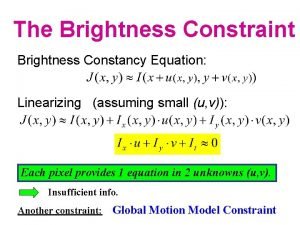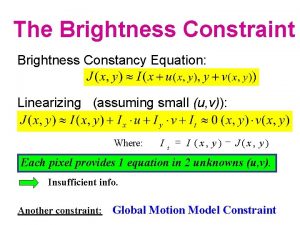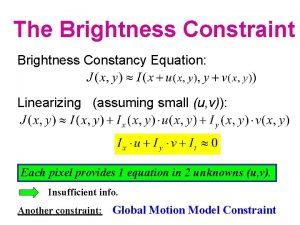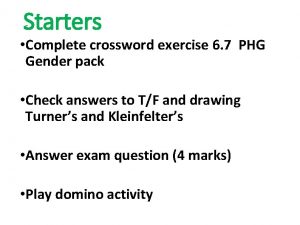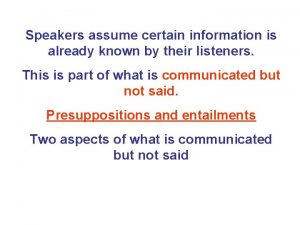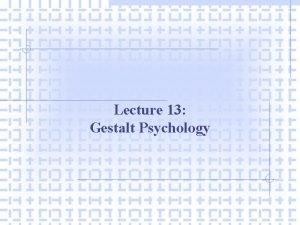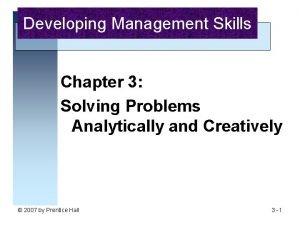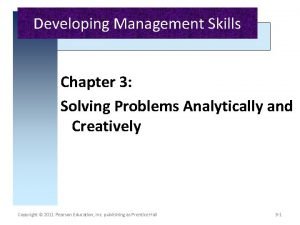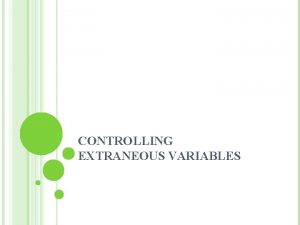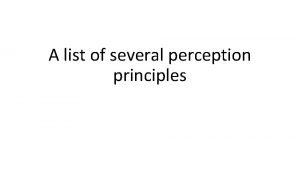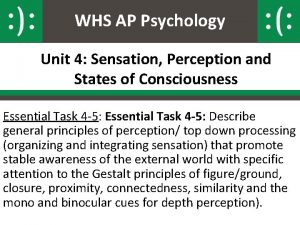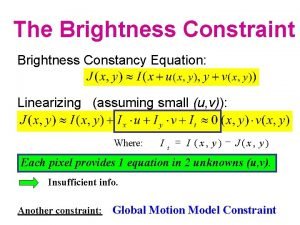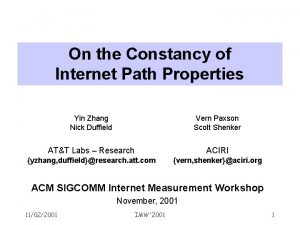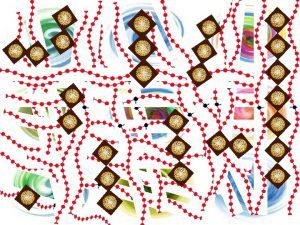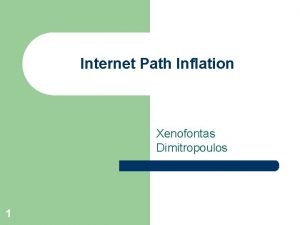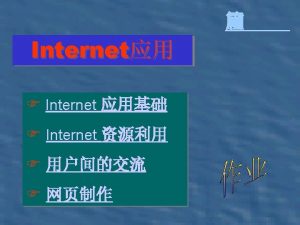On the Constancy of Internet Path Properties Yin























- Slides: 23

On the Constancy of Internet Path Properties Yin Zhang Nick Duffield Vern Paxson Scott Shenker AT&T Labs – Research ACIRI {yzhang, duffield}@research. att. com {vern, shenker}@aciri. org ACM SIGCOMM Internet Measurement Workshop November, 2001 11/02/2001 IMW'2001 1

Talk Outline n n Motivation Three notions of constancy n n Constancy of three Internet path properties n n Mathematical Operational Predictive Packet loss Packet delays Throughput Conclusions 11/02/2001 IMW'2001 2

Motivation n Recent surge of interest in network measurement n n Mathematical modeling Operational procedures Adaptive applications Measurements are most valuable when the relevant network properties exhibit constancy n n Constancy: holds steady and does not change We will also use the term steady, when use of “constancy” would prove grammatically awkward 11/02/2001 IMW'2001 3

Mathematical Constancy n A dataset is mathematically steady if it can be described with a single time-invariant mathematical model. n n n Simplest form: IID – independent and identically distributed Key: finding the appropriate model Examples n Mathematical constancy n n Session arrivals are well described by a fix-rate Poisson process over time scales of 10 s of minutes to an hour [PF 95] Mathematical non-constancy n 11/02/2001 Session arrivals over larger time scales IMW'2001 4

Operational Constancy n Operational constancy n A dataset is operationally steady if the quantities of interest remain within bounds considered operationally equivalent n n Key: whether an application cares about the changes Examples n Operationally but not mathematically steady n n Loss rate remained constant at 10% for 30 minutes and then abruptly changed to 10. 1% for the next 30 minutes. Mathematically but not operationally steady n 11/02/2001 Bimodal loss process with high degree of correlation IMW'2001 5

Predictive Constancy n Predictive constancy n A dataset is predictively steady if past measurements allow one to reasonably predict future characteristics n n Key: how well changes can be tracked Examples n Mathematically but not predictively steady n n IID processes are generally impossible to predict well Neither mathematically nor operationally steady, but highly predictable n 11/02/2001 E. g. RTT IMW'2001 6

Analysis Methodology n Mathematical constancy n n n Operational constancy n n Identify change-points and partition a timeseries into change-free regions (CFR) Test for IID within each CFR Define operational categories based on requirements of real applications Predictive constancy n Evaluate the performance of commonly used estimators n n n 11/02/2001 Exponentially Weighted Moving Average (EWMA) Moving Average (MA) Moving Average with S-shaped Weights (SMA) IMW'2001 7

Testing for Change-Points n Identify a candidate change-point using CUSUM Ck = i=1. . k (Ti – E(T)) Ti E(T) n Apply a statistical test to determine whether the change is significant n CP/Rank. Order: n n CP/Bootstrap: n n Based on Fligner-Policello Robust Rank-Order Test [SC 88] Based on bootstrap analysis Binary segmentation for multiple change-points n Need to re-compute the significance levels 11/02/2001 IMW'2001 8

Measurement Methodology n Two basic types of measurements n Poisson packet streams (for loss and delay) n n TCP transfers (for throughput) n n Payload: 64 or 256 bytes; rate: 10 or 20 Hz; duration: 1 Hour. Poisson intervals unbiased time averages [Wo 82] Bi-directional measurements RTT 1 MB transfer every minute for a 5 -hour period Measurement infrastructure n NIMI: National Internet Measurement Infrastructure n n n 11/02/2001 35 -50 hosts ~75% in USA; the rest in 6 countries Well-connected: mainly academic and laboratory sites IMW'2001 9

Datasets Description n Two main sets of data n n Winter 1999 -2000 (W 1) Winter 2000 -2001 (W 2) Dataset W 1 # NIMI # packet # thruput # packets # transfers sites traces 31 2, 375 140 M 58 16, 900 W 2 49 1, 602 113 M 111 31, 700 W 1 + W 2 49 3, 977 253 M 169 48, 600 11/02/2001 IMW'2001 10

Individual Loss vs. Loss Episodes n Traditional approach – look at individual losses [Bo 93, Mu 94, Pa 99, YMKT 99]. n n Correlation reported on time scales below 200 -1000 ms Our approach – consider loss episodes n n Loss episode: a series of consecutive packets that are lost Loss episode process – the time series indicating when a loss episode occurs n Can be constructed by collapsing loss episodes and the non-lost packet that follows them into a single point. loss process 0 0 1 1 1 0 0 0 episode process 0 0 1 1 0 0 11/02/2001 IMW'2001 11

Source of Correlation in the Loss Process n Many traces become consistent with IID when we consider the loss episode process Time scale Traces consistent with IID Loss Episode Up to 0. 5 -1 sec 27% 64% Up to 5 -10 sec 25% 55% Correlation in the loss process is often due to back-to-back losses, rather than intervals over which loss rates become elevated and “nearby” but not consecutive packets are lost. 11/02/2001 IMW'2001 12

Poisson Nature of Loss Episodes within CFRs n n Independence of loss episodes within change-free regions (CFRs) Time scale Up to 0. 5 -1 sec IID CFRs 88% IID traces 64% Up to 5 -10 sec 86% 55% Exponential distribution of interarrivals within change-free regions n 85% CFRs have exponential interarrivals Loss episodes are well modeled as homogeneous Poisson process within change-free regions. 11/02/2001 IMW'2001 13

Cumulative Probability Mathematical Constancy of Loss Episode Process n n Change-point test: CP/Rank. Order “Lossy” traces are traces with overall loss rate over 1% Higher loss rate makes the loss episode process less steady 11/02/2001 IMW'2001 14

Operational Constancy of Loss Rate n Loss rate categories n n 0 -0. 5%, 0. 5 -2%, 2 -5%, 5 -10%, 10 -20%, 20+% Probabilities of observing a steady interval of 50 or more minutes Interval 1 min 10 sec n Type Prob. Episode Loss 71% 57% 25% 22% There is little difference in the size of steady intervals of 50 or less minutes. 11/02/2001 IMW'2001 15

Mathematical vs. Operational n Categorize traces as “steady” or “not steady” n whether a trace has a 20 -minute steady region M: Mathematically steady O: Operationally steady MO ¯ ¯ MO MO ¯ Set MO ¯¯ MO Interval 1 min 10 sec 6 -9% 11% 6 -15% 37 -45% 2 -5% 0. 1% 74 -83% 44 -52% Operational constancy of packet loss coincides with mathematical constancy on large time scales (e. g. 1 min), but not so well on medium time scales (e. g. 10 sec). 11/02/2001 IMW'2001 16

Predictive Constancy of Loss Rate Cumulative Probability n What to predict? n The length of next loss free run n n Estimators n n Used in TFRC [FHPW 00] EWMA, SMA Mean prediction error E [ | log (predicted / actual) | ] The parameters don’t matter, nor does the averaging scheme. 11/02/2001 IMW'2001 17

Cumulative Probability Effects of Mathematical and Operational Constancy on Prediction performance is the worst for traces that are both mathematically and operationally steady 11/02/2001 IMW'2001 18

Delay Constancy n Mathematical constancy n Delay “spikes” n A spike is identified when n R’ max{ K·R, 250 ms } (K = 2 or 4) where n n R’ is the new RTT measurement; R is the previous non-spike RTT measurement; The spike episode process is well described as Poisson within CFRs Body of RTT distribution (Median, IQR) n n 11/02/2001 Overall, less steady than loss Good agreement (90 -92%) with IID within CFRs IMW'2001 19

Delay Constancy (cont’d) n Operational constancy n Operational categories n 0 -0. 1 sec, 0. 1 -0. 2 sec, 0. 2 -0. 3 sec, 0. 3 -0. 8 sec, 0. 8+sec n n Not operationally steady n n n Based on ITU Recommendation G. 114 Over 50% traces have max steady regions under 10 min; 80% are under 20 minutes Predictive constancy n n All estimators perform similar Highly predictable in general 11/02/2001 IMW'2001 20

Throughput Constancy n Mathematical constancy n n n Operational constancy n n 90% of time in CFRs longer than 20 min Good agreement (92%) with IID within CFRs There is a wide range Predictive constancy n n All estimators perform very similar Estimators with long memory perform poorly 11/02/2001 IMW'2001 21

Conclusions n Our work sheds light on the current degree of constancy found in three key Internet path properties n IID works surprisingly well n n Different classes of predictors frequently used in networking produced very similar error levels n n What really matters is whether you adapt, not how you adapt. One can generally count on constancy on at least the time scales of minutes n n It’s important to find the appropriate model. This gives the time scales for caching path parameters We have developed a set of concepts and tools to understand different aspects of constancy n Applicable even when the traffic condition changes 11/02/2001 IMW'2001 22

Acknowledgments n n n Andrew Adams Matt Mathis Jamshid Mahdavi Lee Breslau Mark Allman NIMI volunteers 11/02/2001 IMW'2001 23
 Qimata
Qimata Ponzo illusion
Ponzo illusion Brightness constancy assumption
Brightness constancy assumption Brightness constancy equation
Brightness constancy equation Brightness constancy equation
Brightness constancy equation Define gender constancy
Define gender constancy Example of presupposition
Example of presupposition Sensory adaptation definition
Sensory adaptation definition Founders of gestalt psychology
Founders of gestalt psychology Presupposition examples
Presupposition examples Constancy psychology
Constancy psychology Constancy commitment compression complacency
Constancy commitment compression complacency Constancy commitment compression complacency
Constancy commitment compression complacency Elimination of extraneous variables
Elimination of extraneous variables Refractory period men
Refractory period men Size constancy example
Size constancy example Perceptual constancy
Perceptual constancy Color constancy ap psychology
Color constancy ap psychology Phi phenomenon psychology definition
Phi phenomenon psychology definition Monocular cues
Monocular cues Great plan of happiness
Great plan of happiness Brightness constancy
Brightness constancy Homeostasis def
Homeostasis def Expositional constancy
Expositional constancy


